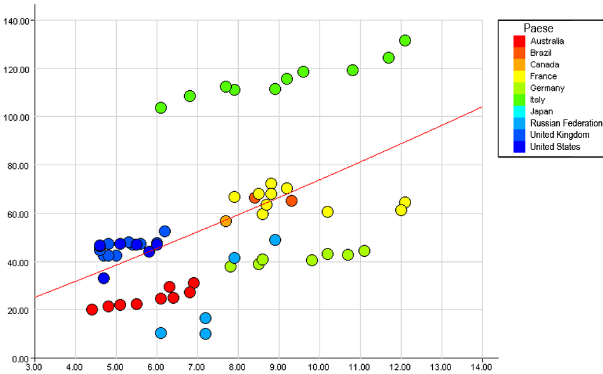Lead and lag indicators are often used in performance management. But what exactly do they mean?
Lead and lag indicators are two types of measurements used in performance evaluation in a company or an organization.
A lead indicator is a predictive measure, such as the percentage of people wearing helmets on a building site.
A lag indicator is an output measure, such as the number of accidents at a building site.
[av_notification title=” color=’green’ border=” custom_bg=’#444444′ custom_font=’#ffffff’ size=’large’ icon_select=’no’ icon=’ue800′ font=’entypo-fontello’ av_uid=’av-luyzw4′]
The difference between the two is that a lead indicator is able to influence change while a lag indicator can only record what happened.
[/av_notification]
Lag indicators are in general easy to measure but difficult to improve or influence, while lead indicators are typically difficult to measure and easy to influence.
CONTENT INDEX
- Lead and lag indicator: the importance of predictive measurement
- The importance of combinations of lead Indicators and lag indicators
- 3 steps to find lead indicators
- Search for known explanatory factors
- Check business processes for new potential explanatory factors
- Choose the strongest potential lead indicators
Lead and lag indicator: the importance of predictive measurement
We focus too often on measuring results. Why? Because they are easy to measure and are accurate.
If you want to know how many sales have been made this month, you can simply count. If you want to know how many accidents have occurred at the factory, you can consult the accident register.
These are all lag indicators. They are a post-event measure, essential for the progress of the charts, but useless when trying to influence the future.
In order to influence the future, a different type of measurement, a predictive measurement, rather than a result measurement, is required.
For example, if you want to increase sales, a predictive measure could be to make more sales calls or run more marketing campaigns.
If you want to reduce accidents at the factory, you could make security training mandatory for all employees or force them to wear helmets.
Measuring these activities provides a series of guiding indicators, predictive measures.
The importance of combinations of lead Indicators and lag indicators
Lead indicators are increasingly difficult to determine with respect to lag indicators. These are predictive indicators and therefore, do not provide a guarantee of success.
This not only makes it difficult to decide which lead indicators to use, but also tends to provoke heated debates on the validity of the measure.
To further fuel the debate, lead indicators often require an investment to implement an initiative before a result is seen and recorded by a lag indicator.
What has become clear after years of research is that a combination of lead and lag indicators leads to improved business performance in general.
When developing a business performance management strategy, it is always a good idea to use a combination of lead and lag indicators.
The reason is obvious; a lag indicator without a lead indicator will not provide guidance on how a result will be achieved and will not provide warnings along the way to a strategic goal.
Moreover, a lead indicator without a lag indicator will not provide confirmation of the achievement of a business result.
There is a chain of cause and effect between the lead and lag indicators, both of which are important when choosing the measures to be followed in order to achieve company goals.
3 steps to find lead indicators
Lead indicators, for some, are the holy grail of performance measures.
They are mysterious, difficult to find and yet regarded as the best and most appreciated performance and KPI measures.
Humans in general have an obsession with the future and, in particular, they want to predict it.
Models of the past can give clues to the future, but it is necessary to make many hypothesis about how future conditions will shape the historical models.
In the case of lead indicators, no historical data on a measure is used to predict how that same measure could behave in the future.
A lead indicator is a measure that suggests how another measure (the measure of lag) may behave in the future.
For example, if you want to forecast future employee turnover, you can look at other measures that have a known impact on staff turnover.
For example, employee engagement or satisfaction towards their work, their manager and their colleagues.
These results can predict staff turnover because they usually start to be negative long before employees decide to leave.
For this reason, a lead indicator has a cause-effect relation to the measure of lag that is to be predicted.
And this gives the power to change things, to influence the future.
Here is the best way to find leads indicators:
1) Search for known explanatory factors
Research if someone else has already established a list of factors that are related to the lag indicator.
For example, if the interest is staff turnover, you can read articles from magazines and periodicals of human resources. Find out if anyone has already tested the factors that most affect the likelihood of staff leaving an organization.
This type of research is important, because it will save a lot of time that would otherwise be wasted by chasing potential indicators of very weak or useless leads.
2) Check business processes for new potential explanatory factors
It is useful to construct a business process scheme to which the lag indicator refers. It is useful for identifying potential steps that have a significant impact.
The use of business processes naturally helps to find the lead indicators. In fact, the initial phases of a process occur before time with respect to the result.
But be careful! Sometimes powerful lead indicators can be found in other business processes that do not directly produce results.
3) Choose the strongest potential lead indicators
When you have a list of potential lead indicators, you need to collect all relevant data. It will therefore be necessary to look for the degree of their relationship with the lag indicator.
In this case, a scatterplot will help to see the strength of the relationships.

Although these suggestions can certainly help identifying lead indicators, practice and experience are absolutely necessaryin order to be able to identify the right ones for each situation.

